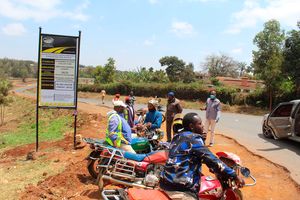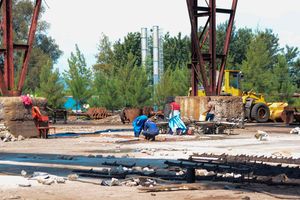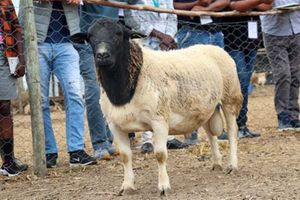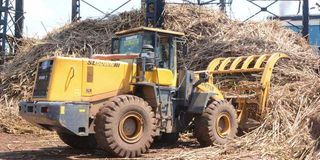
A loader gathers sugar cane at Sony Sugar Company Limited loading yard in Awendo, Migori County, on June 11, 2025.
When Kasmuel Ooko Otieno retired from his teaching job, he returned to his rural home in Awendo, Migori County, and started growing sugar cane like everyone else around.
Five years later, Otieno wants out, having realised that growing cane is not as sweet as its juice. Payments can delay for as long as a year, and when they come they are little.
“It is almost as if you are just planting for the factory,” says Otieno.
Cane takes between 20 to 22 months to mature, which means that with delays some farmers can wait for three years to enjoy the fruits of their labour.
“All that period you are just waiting for peanuts,” notes Otieno.
If anything, some like 54-year-old Japheth Maindu, have memories of being robbed of the little cash they had sunk into cane growing.
Mr Maindu, a resident of Matungu, Kakamega County, started supplying Mumias Sugar Company with sugar cane in the early 1990s.
He was among the lucky few who could read the statement of account when it came from Mumias Sugar Company, by then the only miller in the vicinity. Often, the statement would have the initials ‘DR’ in places where farmers expected to find figures about their payment.
Initially, the farmers thought the DR-ordeal, or the debit position where they owed the sugar factory, would end after the first harvest. But to their consternation, this DR did not disappear even in the next payment cycle.
Maindu is convinced that their perpetual debt positions can be traced to the mismanagement of Mumias Out-growers Company (Moco), which was supposed to represent farmers who delivered cane to Mumias Sugar.
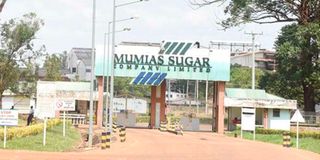
The entrance to Mumias Sugar Company.
According to Maindu, Moco took advantage of the illiteracy of most farmers to fleece them. Although it did not offer any cane development services—ploughing, harrowing, fertiliser, cane seeds—the farmers would pay Moco Sh2.30 every day for all these services, says Maindu.
Moco would also retain 10 percent of what the farmer earned. “They would deduct the services for almost two years. This means all this time, the farmer would go without pay,” remembers Maindu.
That is how most farmers were forced to ditch cane farming altogether as disillusionment with the crop in most parts of Western Kenya set in.
Saulo Busolo, the former chairperson of the defunct Kenya Sugar Board, has been exposed to cane farming from 1974, four years before Nzoia Sugar, in Bungoma, was set up.
Busolo’s farm, where we are doing the interview, was an experimental farm for Nzoia Sugar.
“I can say, the sugar industry is productive of wealth,” says Busolo, noting that it produced wealth that built New York, Boston, Liverpool and London.
“But on our part of the world, we are yet to see that wealth build up something to the stature of Liverpool or New York,” adds Busolo.
Mr Busolo says that the first farmers that delivered were so wealthy that, there is folklore around, that Nzoia made people build mabati houses, helping them to transition from the grass-thatched, mud-walled houses that were common back then.
The synchrony between the farm and factory level, back then, he says, was top-notch. Harvesting was on time, and so was payment.
“The cheques were being taken to farmers’ homes. Can you imagine!”
Today, millions in the so-called sugar belt--the former Western and Nyanza Provinces-- feel that there is no cash from this crop to warrant it the description of ‘cash crop.’
For the optimum running of the mills, the out-grower farms will supplement the millers’ nucleus estates.
You need at least 29,000 hectares of land--both from the nucleus estate and outgrowers farms-- to run a sugar factory.
Sugar cultivation is so labour-intensive—requiring relentless work from planting, harvesting and transporting—that in the 18th century, European settlers in the Americas turned to enslaved African labour to meet the brutal demands of large-scale production.
Then there is also the waiting.
It is not just the sweat and blood at the growing stage that produces the white crystals. It is also in the interest of the farmer for the miller to be rigorous in extracting sucrose, or the sweet juice, from the cane, as much as the miller would like the farmer to grow sucrose-rich cane.
Ideally, a good cane should have between 13 to 14 percent sucrose content and the miller should recover nearly all of it, at least 98 percent.
To ensure sugarcane has enough sucrose, farmers must provide adequate irrigation, apply the right fertilizers at key growth stages, and harvest the cane at the peak of maturity.
Because the initial cost is prohibitive for most farmers, most sugar factories have been supporting farmers with inputs, technical advice, and guaranteed markets. This has helped them secure raw materials for continuous production and reduce the risk of supply shortages.
When we met Fred Oketch, the consultant for Busia Sugar Industry which won the 30-year lease for South Nyanza Sugar Company (Sony), he was just coming from the field where he had supervised farmers on how to cut cane.

South Nyanza Sugar Company Limited (Sony Sugar). In a nutshell, Sony Sugar needs an overhaul to have it roar back into full operations and efficiency.
The quality of harvesting of cane, Oketch told us, is one key area which most factories ignore.
“You cannot be efficient in producing sugar if you are milling dirty cane, cane with soil or cane which is not fresh,” said Oketch.
“If you bring soil to the factory, the canine, which is supposed to cut the cane before you bring it to the mill, gets blunt very quickly. That is an expense,” said Oketch.
“When you get to the mill itself, the mill rollers are expensive. When you are grinding soil, the wear rate is very high in the mill. And the rollers are very expensive. It is over a million per roller,” said Oketch who has been in the industry for over 40 years.
He says a mill like the one at Sony will require at least 12 rollers, which means the company will need Sh12 million to replace them.
This soil will also find its way into the juice. The pan (where sugar crystallization of sugar occurs) will wear very fast. That pan is also very expensive, Oketch says.
It is such small oversights that make factories inefficient, pushing up the cost of producing sugar in the country compared to its peers in the region and making it hard for farmers to be paid.
Cane cutting is an art. If you cut so high to avoid the soil, you might leave out the bottom part that has the most sucrose.
But if you cut so low, you introduce the soils that will make milling inefficient.
“Stacking cane is essential for efficiency and avoidance of bringing soil to the factory. With big stacks you minimize chances of soil coming to the factory,” added Oketch.
Yet the biggest nightmare for farmers is the transport cost. About 40 percent of a farmers’ total cost of production is transport, says Ezron Kotut, the new acting MD for Nzoia Sugar Company, which has been leased to Rai Group’s West Kenya.
Mr Kotut blames the bad roads for the high cost of transport, which has not been reduced even when the government has removed the 16 percent value-added tax (VAT).
The solution, says Kotut, lies in weighing the cane close to the farm to reduce the cost of transportation.
“There was an initial attempt to push the industry to adopt the weight bridge that is mobile so that it can be placed at a strategic place near to the farmer’s farm,” says Kotut.
The pricing of sugarcane in Kenya remains so opaque that many farmers have no idea how much they will be paid for their crop.
Despite spending months nurturing their cane, they are often left in the dark about the prevailing rates, with factory deductions and grading systems rarely explained.
The situation is worse for small-scale farmers, many of whom never even get their cane to the weighbridge—either because of lack of transport, middlemen interference, or rejection by millers.
As a result, they are forced to accept whatever payment is offered, if any, reinforcing a cycle of exploitation and poverty in cane-growing regions.
With zoning, contracted farmers risked being arrested if they sold the crop to a competitor.
“You could not even use the cane to make your own jaggery (sukari nguru). They (Mumias officers) would ask you where you got the cane and it is only Mumias with the monopoly for maize,” added Maindu.
Such a labour-intensive, capital-heavy industry as the sugar industry leaves very little room for incompetence, corruption and poor governance that have characterized State-owned sugar companies.
Illegal cheap imports due to weak regulations or corruption only make things for worse for these uncompetitive infant industries.
For years, the government has protected the industry through bail-out of the State-owned millers while shielding them from competition by factories within the Common Market for Eastern and Southern Africa (Comesa), a 21-member free trade area.
Bailouts have robbed taxpayers while Comesa safeguards have hurt consumers, though Benard Soi, the Managing Director for West Valley, insists that the cheap imports have hardly brought down the retail price of sugar.
Interestingly, farmers and workers have still not been paid by the State-owned sugar millers.
By the time the government leased out the four State-owned Sugar Companies to private millers, they owned farmers a total of Sh1.715 billion.
Arrears to farmers by South Nyanza Sugar Company (Sony), where Nicholas delivers his cane, are more than half of this total at Sh865,853,766.
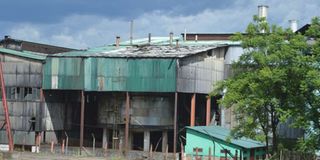
Muhoroni Sugar Company factory in this picture taken on May 27, 2019.
Muhoroni Sugar had arrears of Sh316,651,523 to farmers.
Nzoia Sugar, whose lease has gone to West Kenya, had farmers’ arrears of Sh269,606,266.
Chemelil, whose lease has gone to Kibos Sugar and Allied Industries, owed farmers Sh263,017,939.
The government has promised to clear all these arrears to farmers workers in six months of leasing.
The collapse of sugar-- as well as other key industries like cotton and paper—during the 1990s devastated Western Kenya’s economy, plunging thousands into deeper penury.
By the late 1990s, Mumias Sugar Company, which had supported over 100,000 farmers and indirectly impacted nearly 2 million people, was struggling with payment delays stretching over six months.
At the same time, the cotton industry in areas like Busia and Bungoma collapsed due to liberalization policies pushed by the World Bank and International Monetary Fund and the withdrawal of state support, leading to a 70 per cent drop in production between 1985 and 1995.
The closure of Pan Paper Mills in Webuye, Bungoma County, which had employed over 1,500 workers directly and thousands more in the supply chain, further eroded livelihoods.
As these industries fell, household incomes plummeted, food insecurity rose, and essential services became unattainable.
The 1997 Welfare Monitoring Survey by the national statistician showed that poverty levels in Western region surpassed 60 percent, with some districts approaching 70 percent. Child stunting, a key measure of chronic malnutrition, rose sharply, with rates exceeding 40 percent in many communities.
A ray of hope would be seen in the mushrooming of private millers, led by the Rai companies.
But things get worse for the State-owned sugar companies as the General elections of 2017 approached. Suddenly, the market was flooded with cheap sugar imports from Brazil, says Kotut.
Mr Kotut says things got worse for the entire industry around this time with some millers such as Muhoroni and Mumias going under receivership.
“Because the imports that came in were around two years production of Kenya,” notes Kotut.
That year, a bag of sugar was going for around Sh3,000 per bag against the cost of production of between Sh4,000 and Sh4,500.
“So we were making straight losses. And that is how we ended up having huge debts in terms of paying suppliers, in terms of actually paying our obligations,” adds Kotut.
It is around this time that President Ruto’s economic adviser David Ndii exhorted the people of Western region to simply abandon sugarcane, noting that it was not profitable.
To Dr Ndii the out-grower model adopted by Kenya could not succeed with sugarcane as small-holding farms had in tea.
Industry players, however, disagree. Instead, they are pushing for farmers to adopt better crop husbandry to improve yields per acre and sucrose content in the cane.
Practices that could help a farmer get up 50 tonnes of cane from an acre of land include preparing land at the right time, observing the ploughing depth and planting intervals, says Idris Bashir, a manager at Busia Sugar Industry.
Soil testing, use of fertilizers and weeding at the right time are also critical, according to Bashir.
“These practices will help you get the right amount of harvest,” said Bashir, encouraging farmers to practice intercropping to get both cash and food from their lands.
Mr Oketch counters by noting that countries like Mauritius have been successful with smallholder plantations through efficiency.
At the factory level, Oketch notes that the collapse of Mumias Sugar is a stark reminder that big is not necessarily smart.
Mr Busolo has a lot of faith in cane, noting it is the only crop that it is the only viable source of employment in the Western region due to its supply chain--transporters, weeders, cane cutters, factory workers.
But, first, the government needs to pay the farmers all their arrears if some of them are to start delivering cane to the private investors.
The Sugar Board, which has been brought back through the new Sugar Act 2024, is expected to come up with new cane varieties that can mature within a year.
“Because the varieties which we have been using are those conventional varieties which came from India so many years ago,” says Kotut.
The industry also intends to move to a pricing formula that will see the farmer paid on the weight of the cane as well as the sucrose content. The formula will also include other byproducts like bagasse and molasses which farmers have not benefited from.
“That means that a farmer who has cultivated his crop well, then he will be able to get more,” says Kotut.
Fifty-four-year-old resident of Busia County Gilbert Oduor is not complaining, noting that for him returns from cane have exceeded those from maize.
Mr Oduor does not rely on millers for cane development. “I do everything on my own, I do not rely on millers,” he adds, noting that he takes his harvest where the price is good.
“Sugar is sweet, but in the process of getting that sugar, you might have a lot of sweat. You might have a few tears here and there, but at the end of it, we should all smile,” said Bashir.
Read also:
TOMORROW: How the sweetness of the billions in cane comes from various by-products

